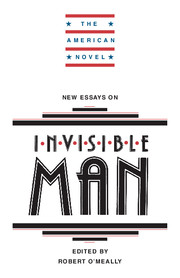Book contents
- Frontmatter
- Contents
- Series Editor's Preface
- 1 Introduction
- 2 The Meaning of Narration in Invisible Man
- 3 Frequencies of Eloquence: The Performance and Composition of Invisible Man
- 4 Ralph Waldo Ellison: Anthropology, Modernism, and Jazz
- 5 Ellison's Masks and the Novel of Reality
- 6 The Conscious Hero and the Rites of Man: Ellison's War
- Notes on Contributors
- Selected Bibliography
2 - The Meaning of Narration in Invisible Man
Published online by Cambridge University Press: 05 June 2012
- Frontmatter
- Contents
- Series Editor's Preface
- 1 Introduction
- 2 The Meaning of Narration in Invisible Man
- 3 Frequencies of Eloquence: The Performance and Composition of Invisible Man
- 4 Ralph Waldo Ellison: Anthropology, Modernism, and Jazz
- 5 Ellison's Masks and the Novel of Reality
- 6 The Conscious Hero and the Rites of Man: Ellison's War
- Notes on Contributors
- Selected Bibliography
Summary
In Ralph Ellison's essays and interviews, the artist is a figure of rebellion. Whether writing generally of the role and responsibilities of the contemporary American novelist or, more specifically, of his own achievements, Ellison describes the artist always in opposition to the restraints of received literary convention. In “Brave Words for a Startling Occasion,” his acceptance speech for the 1953 National Book Award, he identifies some of the restrictions that limit modern American fiction. For him, neither the “tight, well-made Jamesian novel” nor the “hard-boiled novel” can contain the complexity of American life. He writes:
There was also a problem of language, and even dialogue, which, with its hard-boiled stance and its monosyllabic utterance, is one of the shining achievements of twentieth-century American writing. For despite the notion that its rhythms were those of everyday speech, I found that when compared with the rich babel of idiomatic expression around me, a language full of imagery and gesture and rhetorical canniness, it was embarrassingly austere.
In response to these constraints, he suggests that the contemporary novelist assume an adversarial posture; he or she must “challenge the apparent forms of reality – that is, the fixed manners and values of the few, and … struggle with it until it reveals its mad, vari-implicated chaos, its false faces, and … until it surrenders its insight, its truth” (SA, 106).
- Type
- Chapter
- Information
- New Essays on Invisible Man , pp. 25 - 54Publisher: Cambridge University PressPrint publication year: 1988
- 2
- Cited by



